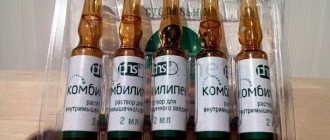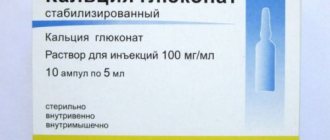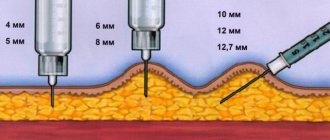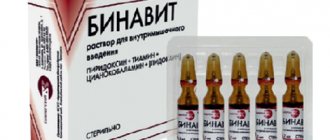Ciprofloxacin
Ciprofloxacin is administered as an intravenous infusion lasting at least 30 minutes (200 mg) and 60 minutes (400 mg). The dose of ciprofloxacin depends on the severity of the disease, type of infection, body condition, age, weight and kidney function of the patient.
Typically recommended doses for intravenous administration: single dose - 200 mg (for severe infections - 400 mg), frequency of administration - 2 times a day; The duration of treatment depends on the severity of the disease - 1-2 weeks, or more if necessary.
For lower respiratory tract infections, 200-400 mg 2 times a day.
For urinary tract infections: acute uncomplicated - 100 mg 2 times a day; cystitis in women (before menopause) - once 100 mg; complicated - 200 mg 2 times a day.
For uncomplicated gonorrhea - 100 mg once, for extragenital gonorrhea - 100 mg 2 times a day.
Infectious diarrhea - 200 mg 2 times, course of treatment - 5-7 days.
Particularly severe infections (streptococcal pneumonia, infectious complications of cystic fibrosis, infections of bones and joints, septicemia, peritonitis), especially those caused by Pseudomonas, Staphylococcus - 400 mg 3 times a day.
Pulmonary anthrax (treatment and prevention): 400 mg 2 times a day.
For the prevention of infections during surgical interventions - 0.2-0.4 g 0.5-1 hour before surgery; if the operation lasts more than 4 hours, it is re-administered in the same dose.
Elderly patients are prescribed lower doses depending on the severity of the infection and the QC value.
In pediatrics:
When treating complications caused by Pseudomonas aeruginosa in children with cystic fibrosis of the lungs from 5 to 17 years old - 10 mg/kg 3 times a day (maximum dose 1200 mg). The duration of treatment is 10-14 days.
For pulmonary anthrax (prevention and treatment) - 10 mg/kg 2 times a day. The maximum single dose is 400 mg, daily dose is 800 mg. The total duration of taking ciprofloxacin is 60 days.
CRF: with a glomerular filtration rate (CK 31-60 ml/min/1.73 sq.m or serum creatinine concentration from 1.4 to 1.9 mg/100 ml), the maximum daily dose is 800 mg. With a glomerular filtration rate (CC below 30 ml/min/1.73 sq.m or serum creatinine concentration above 2 mg/100 ml) and during hemodialysis, the maximum daily dose is 400 mg; during hemodialysis, ciprofloxacin is administered after a hemodialysis session.
An infusion solution of ciprofloxacin is added to the dialysate (intraperitoneal): 50 mg of ciprofloxacin per liter of dialysate is administered 4 times a day every 6 hours.
Average duration of treatment: 1 day - for acute uncomplicated gonorrhea and cystitis; up to 7 days - for infections of the kidneys, urinary tract and abdominal cavity; during the entire period of the neutropenic phase in patients with immunodeficiency, but not more than 2 months. - for osteomyelitis and 7-14 days - for all other infections. For streptococcal infections, due to the risk of late complications, treatment should continue for at least 10 days. Treatment is carried out for at least 3 days after normalization of body temperature or disappearance of clinical symptoms.
Ready-to-use infusion solutions can be combined with 0.9% sodium chloride solution, Ringer's solution and Ringer-lactate, 5 and 10% dextrose solution, 10% fructose solution, as well as a solution containing 5% dextrose solution with 0.225% or 0.45% sodium chloride solution.
Ciprofloxacin solution for infusion 2 mg/ml 100 ml bottle 1 pc. in Moscow
Prescribed intravenously (drip)
for 30 minutes (200 mg) and 60 minutes (400 mg).
The dose of ciprofloxacin depends on the severity of the disease, type of infection, body condition, age, weight and kidney function of the patient.
Recommended Doses
For lower respiratory tract infections - 200-400 mg 2 times a day.
For urinary tract infections: acute uncomplicated - 100 mg 2 times a day; cystitis in women (before menopause) - 100 mg once; complicated - 200 mg 2 times a day.
For uncomplicated gonorrhea - 100 mg once; for extragenital gonorrhea - 100 mg 2 times a day.
For infectious diarrhea - 200 mg 2 times a day, course of treatment - 5-7 days.
For other infections (depending on severity) - a single dose is 200-400 mg, frequency of administration - 2 times a day.
For particularly severe life-threatening infections (streptococcal pneumonia, infectious complications of cystic fibrosis, infections of bones and joints, septicemia, peritonitis), especially those caused by Pseudomonas spp. Staphylococcus spp. and Streptococcus spp.
the dose is increased to 400 mg 3 times a day.
For the prevention of postoperative infections - 30-60 minutes before surgery, 200-400 mg intravenously; if the operation lasts more than 4 hours, it is re-administered in the same dose.
For pulmonary anthrax (treatment and prevention), 400 mg is administered 2 times a day (maximum single dose - 400 mg, maximum daily dose - 800 mg). Treatment should begin immediately after suspected or confirmed infection. The total duration of treatment with ciprofloxacin for pulmonary anthrax is 60 days.
If kidney function is impaired
With a creatinine clearance of 31 to 60 ml/min or a serum creatinine concentration of 14 to 19 mg/100 ml, the maximum dose of ciprofloxacin for intravenous administration should be 800 mg per day.
With a creatinine clearance of 30 ml/min or less or a serum creatinine concentration of 20 mg/100 ml or more, the maximum dose of ciprofloxacin for intravenous administration should be 400 mg per day.
In hemodialysis, ciprofloxacin is administered after the hemodialysis session.
During peritoneal dialysis, a solution of ciprofloxacin is added to the dialysate (intraperitoneally) at a dose of 50 mg per 1 liter of dialysate every 6 hours.
In case of liver dysfunction
No dose adjustment is required for patients with impaired liver function.
For elderly patients
Elderly patients are prescribed lower doses depending on the severity of the infection and the QC value.
In pediatrics
For pulmonary anthrax (treatment and prevention) - 10 mg/kg body weight 2 times a day (maximum single dose - 400 mg, maximum daily dose - 800 mg). The total duration of treatment is 60 days.
In the treatment of complications caused by Pseudomonas aeruginosa
in children with cystic fibrosis of the lungs aged 5 to 17 years - 10 mg/kg body weight 3 times a day (maximum daily dose - 1200 mg). The duration of treatment is 10-14 days.
Duration of treatment
For acute uncomplicated gonorrhea and cystitis - 1 day.
For infections of the kidneys, urinary tract and abdominal cavity - up to 7 days.
In patients with reduced immunity (except for cases of osteomyelitis) - throughout the entire neutropenic phase. For osteomyelitis, treatment can last no more than 2 months.
For all other infections - 7-14 days. For streptococcal infections, due to the risk of late complications, treatment should continue for at least 10 days.
Treatment should be continued for at least 3 more days after body temperature normalizes or clinical symptoms disappear.
After intravenous use, treatment can be continued orally.
Compatibility with other solutions
Ciprofloxacin infusion solution is compatible with 09% sodium chloride solution 5% or 10% glucose solution (dextrose) with a mixture of 5% glucose solution (dextrose) and 0225% sodium chloride solution with a mixture of 5% glucose solution (dextrose) and 045% sodium chloride solution 10% fructose solution, Ringer's solution, lactated Ringer's solution.
Ciprofloxacin-Promed – solution, concentrate
IV infusion; The infusion duration is 30 minutes at a dose of 200 mg and 60 minutes at a dose of 400 mg. Ready-to-use infusion solutions can be mixed with 0.9% NaCl solution, Ringer's solution and Ringer-lactate, 5 and 10% dextrose solution, 10% fructose solution, as well as a solution containing 5% dextrose solution with 0.225-0.45% NaCl solution .
For lower respiratory tract infections, 200-400 mg 2 times a day.
For urinary tract infections: acute uncomplicated - 100 mg 2 times a day; cystitis in women (before menopause) - once 100 mg; complicated - 200 mg 2 times a day.
For uncomplicated gonorrhea - 100 mg once, for extragenital gonorrhea - 100 mg 2 times a day.
Infectious diarrhea - 200 mg 2 times, course of treatment - 5-7 days.
Particularly severe infections (streptococcal pneumonia, infectious complications of cystic fibrosis, infections of bones and joints, septicemia, peritonitis), especially those caused by Pseudomonas, Staphylococcus - 400 mg 3 times a day.
Pulmonary anthrax (treatment and prevention): 400 mg 2 times a day.
For the prevention of infections during surgical interventions - 0.2-0.4 g 0.5-1 hour before surgery; if the operation lasts more than 4 hours, it is re-administered in the same dose.
For other infections (depending on the severity) - 200-400 mg 2 times a day.
Elderly patients are prescribed lower doses depending on the severity of the infection and the QC value.
In pediatrics:
in the treatment of complications caused by Pseudomonas aeruginosa in children with cystic fibrosis of the lungs from 5 to 17 years - 10 mg/kg 3 times a day (maximum dose 1200 mg). The duration of treatment is 10-14 days.
For pulmonary anthrax (prevention and treatment) - 10 mg/kg 2 times a day. The maximum single dose is 400 mg, daily dose is 800 mg. The total duration of taking ciprofloxacin is 60 days.
CRF: with a glomerular filtration rate (CK 31-60 ml/min/1.73 sq.m or serum creatinine concentration from 1.4 to 1.9 mg/100 ml), the maximum daily dose is 800 mg. With a glomerular filtration rate (CC below 30 ml/min/1.73 sq.m or serum creatinine concentration above 2 mg/100 ml) and during hemodialysis, the maximum daily dose is 400 mg; during hemodialysis, ciprofloxacin is administered after a hemodialysis session.
For peritoneal dialysis, the infusion solution is added to the dialysate (intriperitoneally) at a dose of 50 mg per 1 liter of dialysate 4 times a day (every 6 hours).
Average course of treatment: 1 day - for acute uncomplicated gonorrhea and cystitis; up to 7 days - for infections of the kidneys, urinary tract and abdominal cavity, during the entire period of the neutropenic phase - in patients with weakened body defenses, but no more than 2 months - for osteomyelitis and 7-14 days - for all other infections. For streptococcal infections, due to the risk of late complications, treatment should continue for at least 10 days. In patients with immunodeficiency, treatment is carried out throughout the entire period of neutropenia.
Treatment should be continued for at least 3 more days after body temperature normalizes or clinical symptoms disappear.
After IV use, you can continue treatment orally.
Ciprofloxacin (for infusion), 1 piece, 100 ml, 2 mg/ml, solution for intravenous administration
Suction
After an intravenous infusion of the drug at a dose of 200 mg or 400 mg, Cmax is reached after 60 minutes and is 2.1 μg/ml and 4.6 μg/ml, respectively.
Distribution
Plasma protein binding - 20-40%. Vd - 2-3 l/kg. Ciprofloxacin is well distributed in body tissues (with the exception of fat-rich tissues, such as nervous tissue). The antibiotic content in tissues is 2-12 times higher than in plasma. Therapeutic concentrations are achieved in saliva, tonsils, liver, gall bladder, bile, intestines, abdominal and pelvic organs, uterus, seminal fluid, prostate tissue, endometrium, fallopian tubes and ovaries, kidneys and urinary organs, lung tissue, bronchial secretions , bone tissue, muscles, synovial fluid and articular cartilage, peritoneal fluid, skin. It penetrates into the cerebrospinal fluid in a small amount, where its concentration in non-inflamed meninges is 6-10% of that in the blood serum, and in inflamed meninges - 14-37%. Ciprofloxacin also penetrates well into the ocular fluid, bronchial secretions, pleura, peritoneum, lymph, and through the placenta. The concentration of ciprofloxacin in blood neutrophils is 2-7 times higher than in serum. The activity of ciprofloxacin is slightly reduced at acidic pH values.
Excreted in breast milk.
Metabolism
Metabolized in the liver (15-30%) with the formation of low-active metabolites (diethylciprofloxacin, sulfociprofloxacin, oxociprofloxacin, formylciprofloxacin).
Removal
With intravenous administration, T1/2 is 5-6 hours. It is excreted mainly by the kidneys by tubular filtration and tubular secretion in unchanged form (with intravenous administration - 50-70%) and in the form of metabolites (with intravenous administration - 10%), the rest - through the gastrointestinal tract. After intravenous administration, the concentration in urine during the first 2 hours after administration is almost 100 times higher than in serum, which significantly exceeds the MIC for most pathogens of urinary tract infections.
Renal clearance - 3-5 ml/min/kg; total clearance - 8-10 ml/min/kg.
Pharmacokinetics in special clinical situations
In chronic renal failure (creatinine clearance>20 ml/min), the percentage of the drug excreted through the kidneys decreases, but accumulation in the body does not occur due to a compensatory increase in drug metabolism and excretion through the gastrointestinal tract. T1/2 in chronic renal failure increases to 12 hours.








